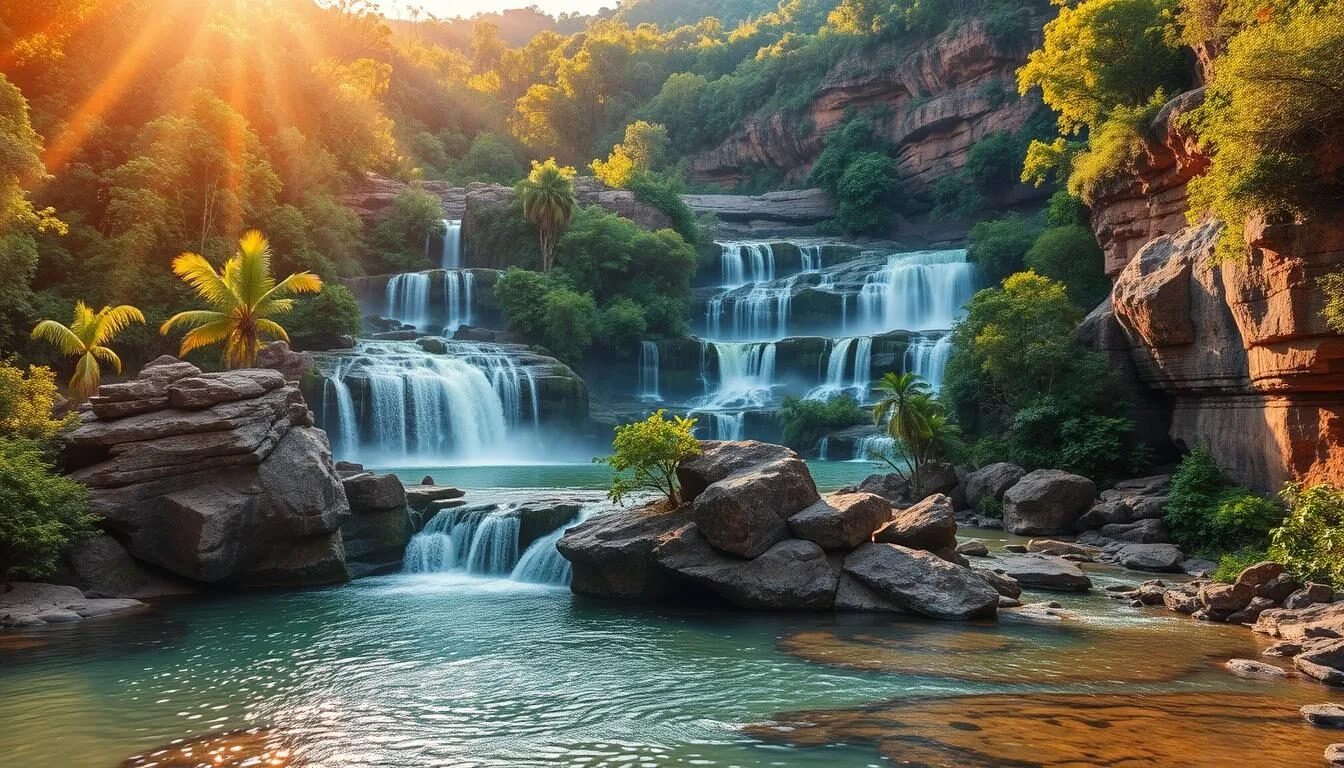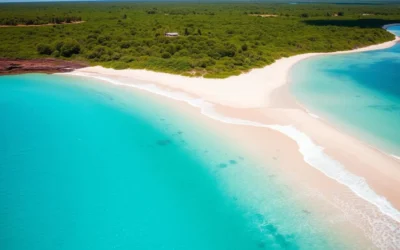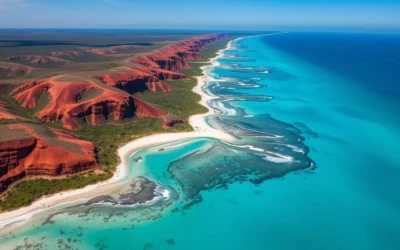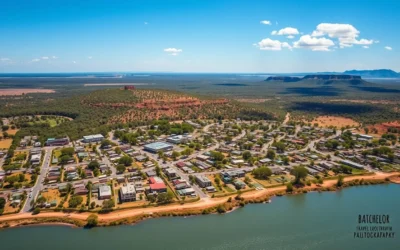Imagine a tropical paradise with gorgeous waterfalls and refreshing swimming holes, just a 90-minute drive from Darwin. You’re about to discover one of Australia’s most spectacular natural playgrounds – a place where the beauty of the northern territory unfolds.
This national park offers a perfect blend of accessibility and natural beauty, making it ideal for both day-trippers and those looking for a longer wilderness experience. With its range of walking trails and thrilling 4WD tracks, you’ll be eager to explore the best that this magnificent park has to offer.
Whether you’re a first-time visitor or returning to explore more, get ready to immerse yourself in the stunning landscapes and unique attractions that make this park a must-visit destination.
Discovering the Magic of Litchfield National Park
Litchfield National Park is a hidden gem waiting to be discovered in the Northern Territory. As you plan your trip to this stunning destination, you’ll find that it offers an unparalleled combination of accessibility and pristine natural beauty.
Location and Overview
Located in the Northern Territory, Litchfield National Park is easily accessible, making it a perfect day-trip or longer stay destination from Darwin. The park is renowned for its waterfalls and swimming holes, which are among the most memorable experiences in Australia.
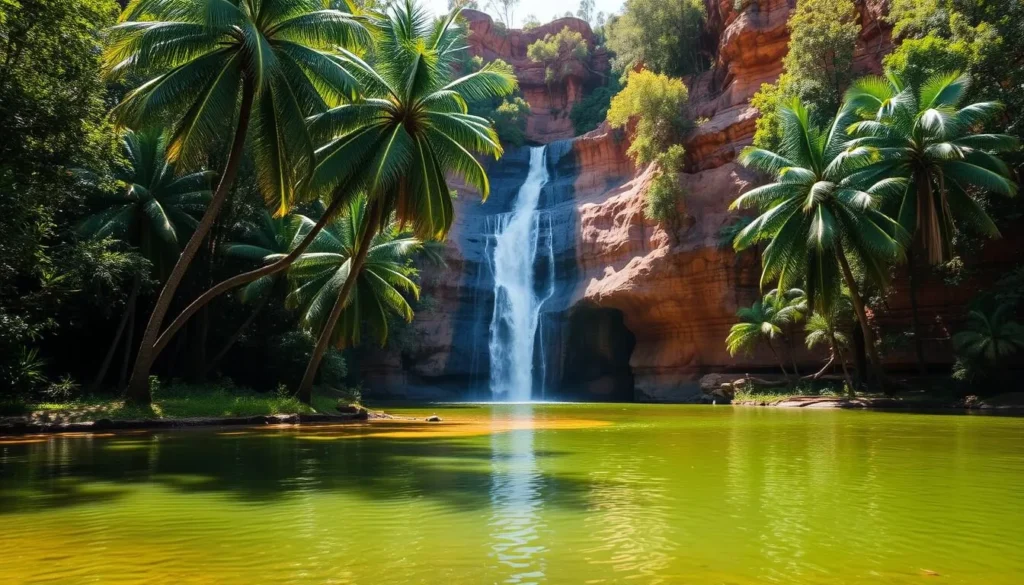
Why Litchfield Should Be On Your Northern Territory Itinerary
You should visit Litchfield National Park because it delivers spectacular scenery and experiences without requiring extensive travel or 4WD vehicles for its main attractions. The park’s diverse attractions cater to all interests, from refreshing swims in crystal-clear pools to hiking, wildlife enthusiasts, and photographers.
While a day trip is possible, you’ll discover that spending at least 2-3 days in the park allows you to experience its magic at different times of day and avoid the crowds at popular swimming holes. This makes Litchfield a must-visit destination in the Northern Territory.
Planning Your Visit to Litchfield National Park
As you prepare for your adventure to Litchfield National Park, here are some crucial details to keep in mind.
Best Time to Visit
The best time to visit Litchfield National Park is during the dry season, from May to September, when the weather is mild and ideal for outdoor activities.
How to Get There
Litchfield National Park is approximately 115 kilometers southwest of Darwin. To get there, take the Stuart Highway towards Katherine, then turn onto Litchfield Park Road. The journey takes around 2 hours by car.
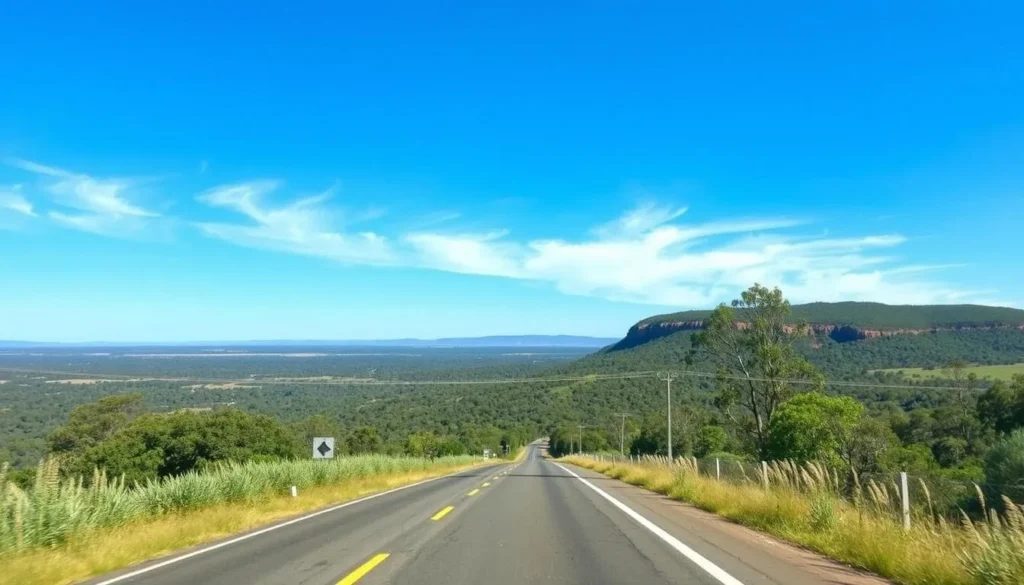
Park Fees and Permits
Unlike many national parks in Australia, Litchfield National Park is free to enter, with no entrance fees or permits required for day visitors. However, camping fees apply if you stay overnight within the park boundary.
- Unlike many national parks in Australia, Litchfield National Park is free to enter, with no entrance fees or permits required for day visitors.
- If you’re planning to camp within the park, you’ll need to pay camping fees which range from $3.30 to $6.60 per person per night depending on the campground.
- For some of the more popular campgrounds like Florence Falls and Wangi Falls, it’s highly recommended to book in advance during the dry season as they fill up quickly.
Litchfield National Park, Northern Territory: Best Things to Do – Top Picks
With its stunning waterfalls and unique rock formations, Litchfield National Park is a treasure trove of natural wonders waiting to be explored. As you venture into this beautiful park, you’ll discover a range of exciting activities and breathtaking sights that make it a must-visit destination in the Northern Territory.
Wangi Falls – The Crown Jewel
Wangi Falls is one of the park’s most iconic attractions, and for good reason. This stunning waterfall is surrounded by lush vegetation and offers a refreshing swimming hole. The falls are easily accessible via a short walk from the car park, making it a great spot for families and those looking for a relaxing day out.
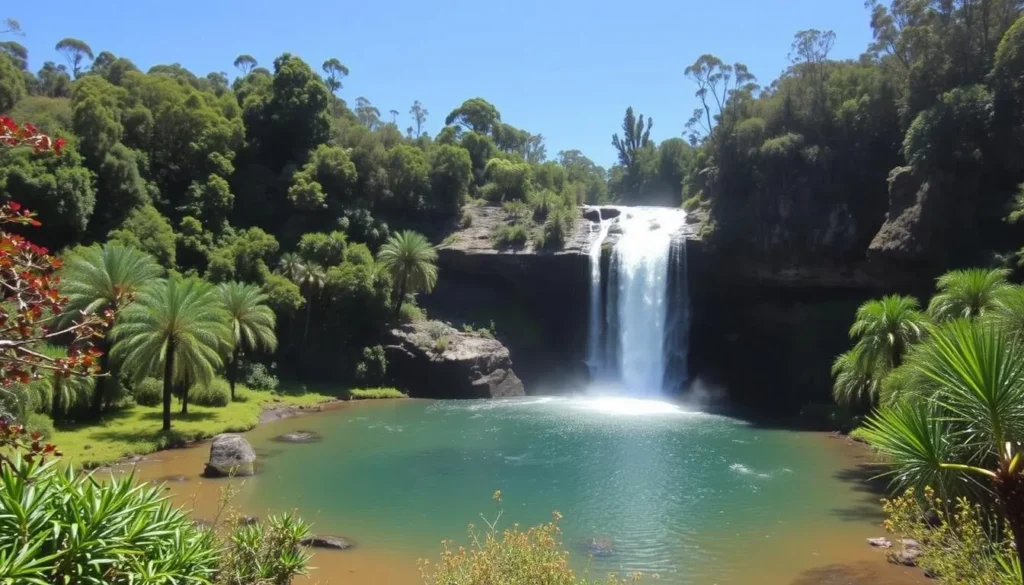
Florence Falls – Double Cascade Paradise
Florence Falls is another highlight of Litchfield National Park, featuring a double cascade that creates a picturesque swimming hole. The falls are surrounded by beautiful scenery, and the swimming area is perfect for cooling off on a hot day. Visitors can enjoy a leisurely swim or simply take in the natural beauty of the surroundings.
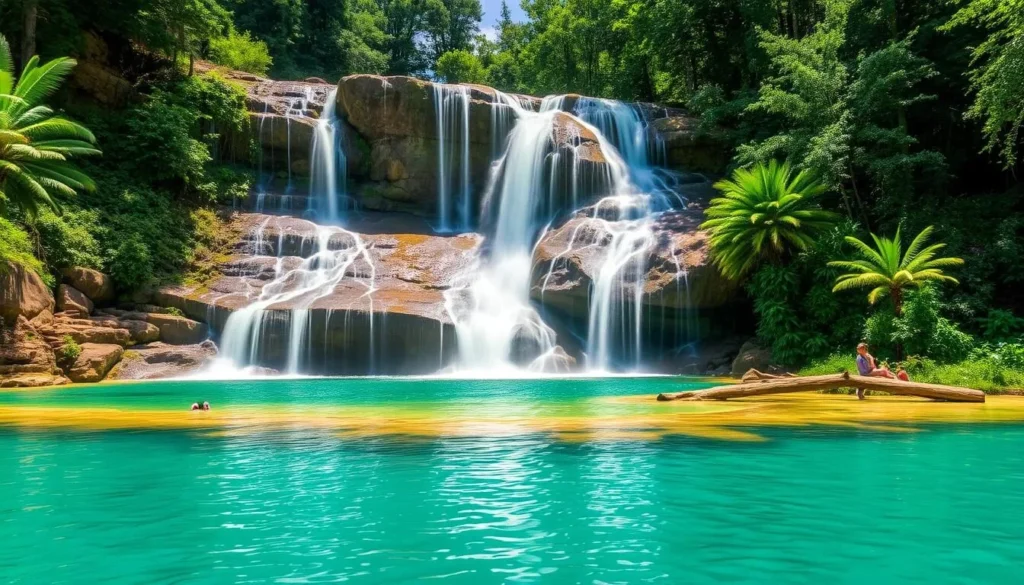
Buley Rockhole – Tiered Natural Pools
Located near Florence Falls, Buley Rockhole is a series of tiered natural pools that offer a unique swimming experience. The clear and refreshing water makes it an ideal spot to cool off, and the varying pool sizes and depths cater to different swimming abilities. Visitors can relax in the natural jacuzzis or float in the crystal-clear pools surrounded by tropical vegetation.
- Buley Rockhole presents a unique swimming experience with its series of cascading rock pools forming natural jacuzzis and relaxing spots to cool off.
- Unlike the larger plunge pools at Wangi and Florence Falls, Buley offers multiple smaller pools where you can find your own space to relax and enjoy the crystal-clear water.
- The tiered nature of the rockhole means you can move between pools of varying depths and water flow, making it perfect for families with children of different swimming abilities.
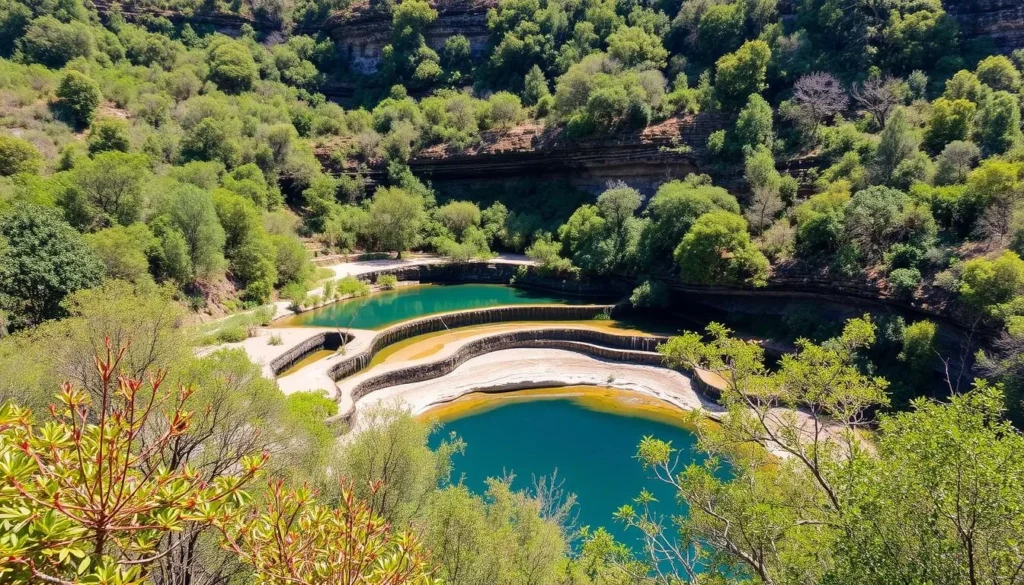
These top attractions in Litchfield National Park offer a glimpse into the park’s natural beauty and diversity. Whether you’re looking to relax or adventure, Litchfield has something for everyone.
More Must-See Waterfalls and Swimming Spots
As you explore Litchfield National Park, you’ll uncover a series of stunning waterfalls and secluded swimming spots. The park’s diverse landscapes create a variety of natural attractions that are sure to captivate any visitor.
Tolmer Falls – Spectacular Views
Tolmer Falls is a breathtaking spectacle, with water cascading down a single drop into a plunge pool below. The surrounding landscape offers spectacular views, making it a perfect spot for photography.
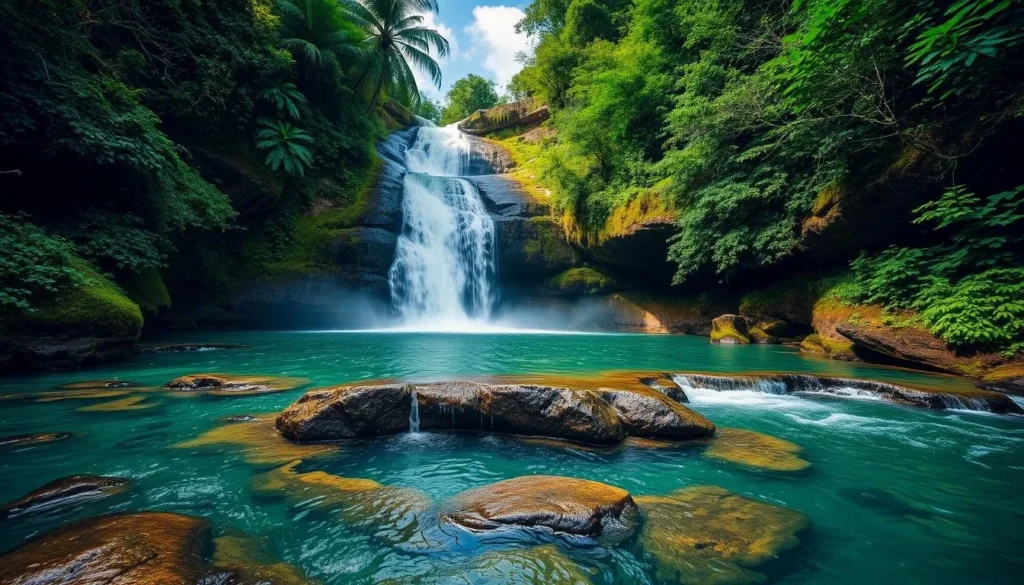
The Cascades – Hidden Gem Swimming Spot
The Cascades is a series of cascading pools and small waterfalls along the creek. It’s a hidden gem that offers a serene swimming experience amidst the natural beauty of the park.
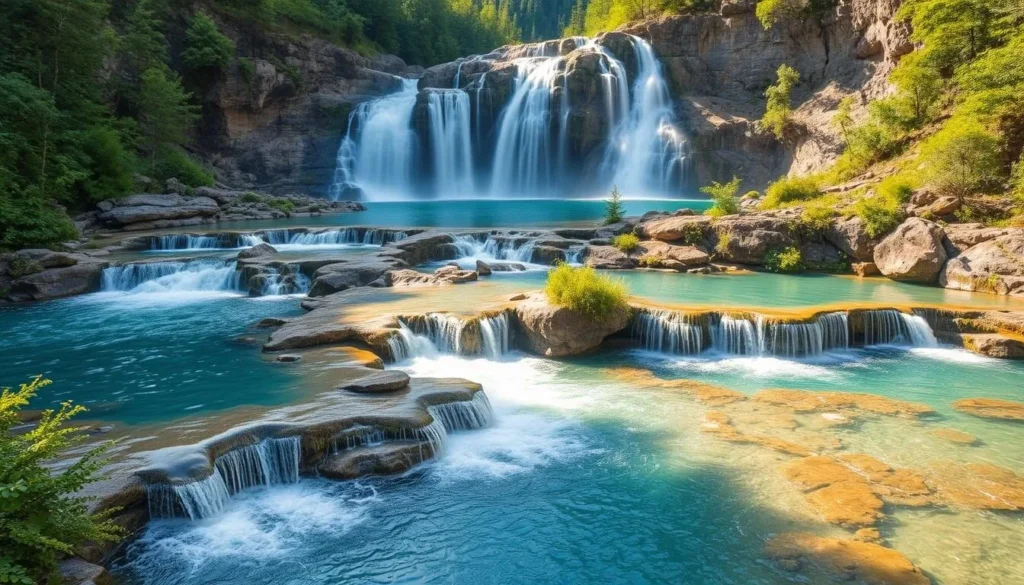
Tjaetaba Falls – Peaceful Plunge Pool
Tjaetaba Falls offers a more secluded swimming experience accessed via the 2.7km return Greenant Creek Walk. The trail takes you through contrasting ecosystems before reaching the peaceful plunge pool above the main waterfall.
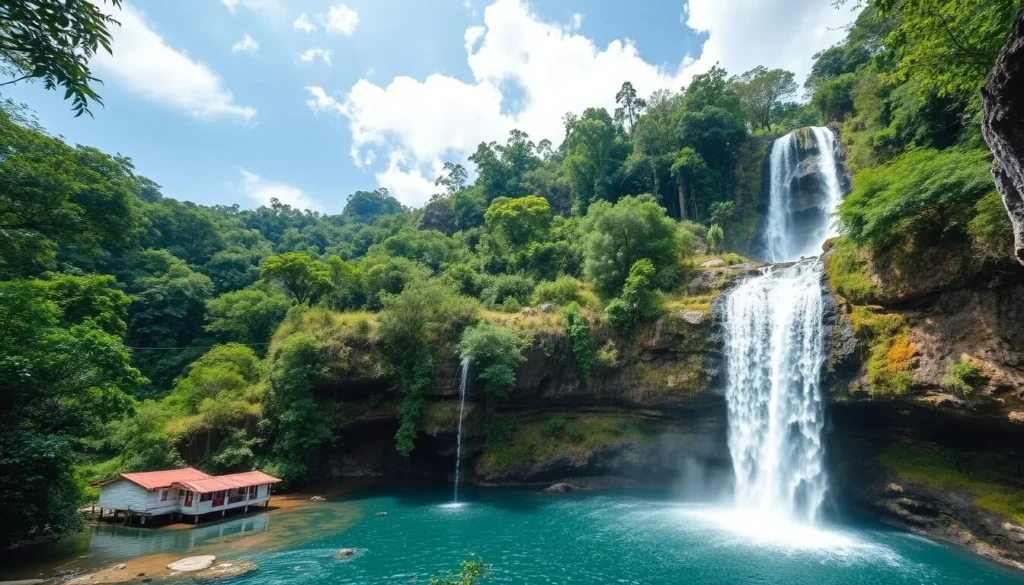
Each of these waterfalls and swimming spots provides a unique experience, showcasing the natural beauty and diversity of Litchfield National Park. Whether you’re looking for a secluded swim or a spot to take in the views, Litchfield has something to offer.
Off the Beaten Path: 4WD Adventures
For adventurous travelers, Litchfield National Park offers thrilling 4WD experiences that take you off the beaten path. Explore rugged terrains, navigate through challenging trails, and discover the park’s hidden gems.
The Lost City – Ancient Rock Formations
The Lost City is a fascinating rock formation that resembles an ancient city. Accessible only by 4WD, this natural wonder is a must-visit for those who love adventure and unique landscapes.
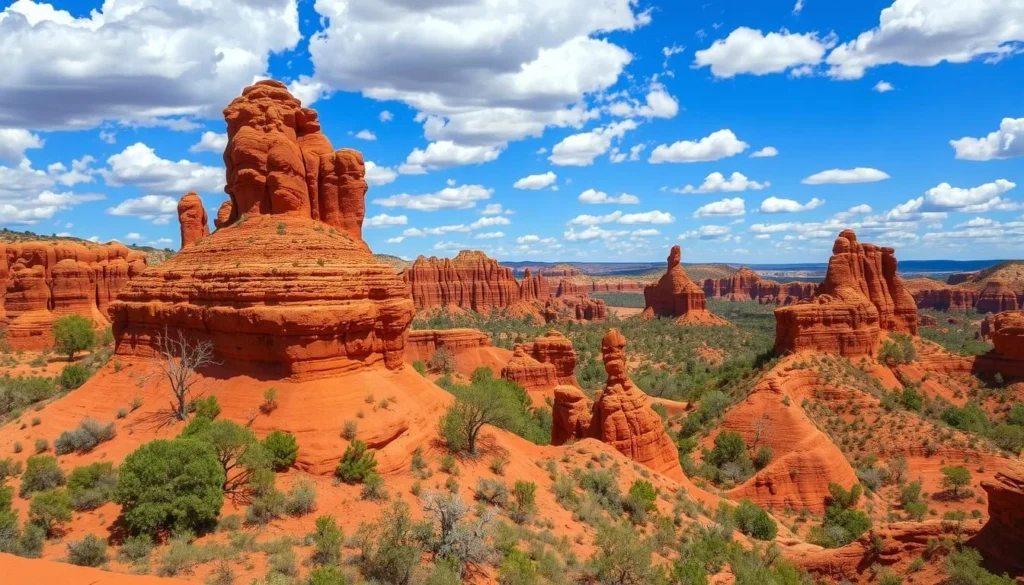
Tjaynera Falls (Sandy Creek) – Secluded Paradise
Tjaynera Falls, also known as Sandy Creek Falls, is a secluded paradise that rewards adventurous travelers with a pristine and uncrowded swimming experience. You’ll need a 4WD vehicle to navigate the 10km unsealed access road, which includes challenging water crossings.
- A moderate 3.4km return walking track leads to the falls, where crystal-clear water cascades into a deep swimming hole.
- The nearby Sandy Creek campground offers a true bush camping experience with basic facilities.
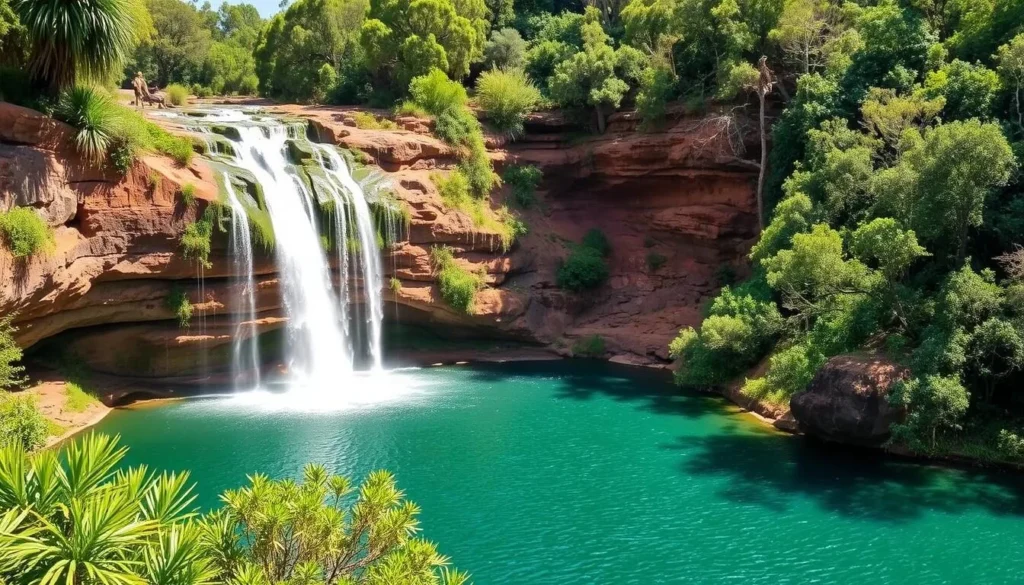
Unique Natural Wonders
As you explore Litchfield National Park, you’ll encounter a variety of natural marvels that showcase the park’s incredible diversity. The park is not just about its famous waterfalls; it is also home to other unique attractions that are worth visiting.
Magnetic Termite Mounds
The Magnetic Termite Mounds are a fascinating example of natural architecture within Litchfield National Park. These mounds, built by termites, are aligned magnetically, showcasing the incredible organizational skills of these tiny creatures. The mounds are a unique sight and provide insight into the natural world.
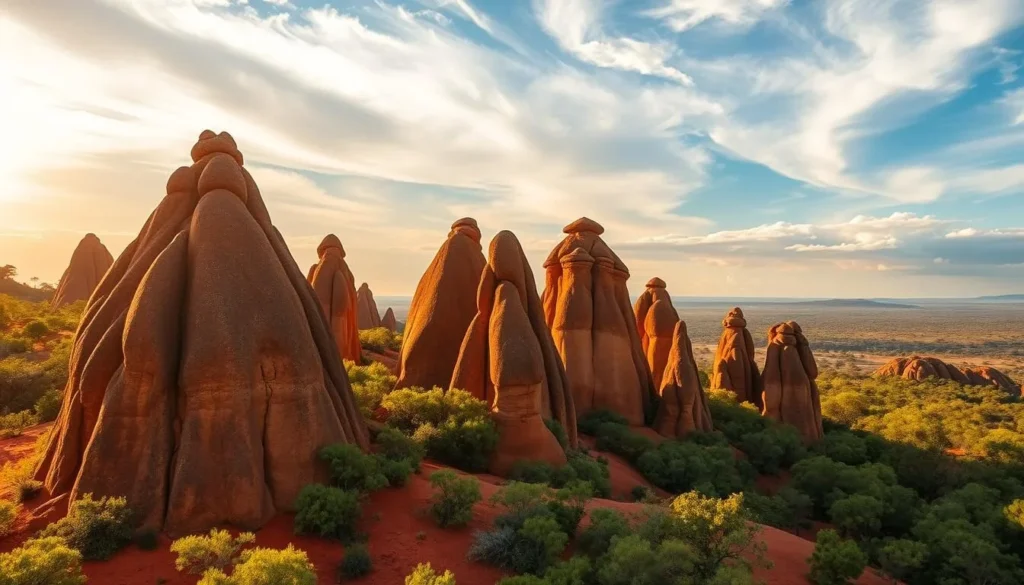
Tabletop Swamp
Tabletop Swamp is a hidden gem in Litchfield National Park, offering a serene wetland environment that contrasts with the park’s more famous rocky landscapes and waterfalls. This seasonal billabong becomes a thriving habitat during and after the wet season, attracting a variety of birdlife, including egrets, herons, ibises, kingfishers, and colorful parrots.
- A short walking track leads to viewing areas where you can quietly observe the wildlife.
- The area is particularly magical in the early morning or late afternoon when birds are most active.
- Despite being well-signed and easily accessible, Tabletop Swamp receives fewer visitors than the popular waterfalls.
| Attraction | Description |
|---|---|
| Magnetic Termite Mounds | Unique termite mounds aligned magnetically, showcasing natural architecture. |
| Tabletop Swamp | A serene wetland area attracting various bird species, ideal for birdwatching. |
Best Walking Trails in Litchfield National Park
Litchfield National Park is a hiker’s paradise, offering a range of walking trails that cater to different fitness levels and interests. Whether you’re looking for a leisurely stroll or a more challenging hike, the park has a walking trail that’s right for you.
Walker Creek Walk – Peaceful Creekside Trail
The Walker Creek Walk is a serene and picturesque trail that follows the creek, offering a tranquil walking experience. This trail is ideal for those looking to connect with nature in a peaceful setting.
Greenant Creek Walk to Tjaetaba Falls
For those seeking a more adventurous walk, the Greenant Creek Walk to Tjaetaba Falls is a great option. This trail takes you through a lush monsoon forest and ends at the beautiful Tjaetaba Falls, a perfect spot for a refreshing swim.
Wangi Falls Loop Walk
The Wangi Falls Loop Walk is a 3km circuit that offers breathtaking views of the surrounding landscape and the falls. This moderately challenging trail is a must-do for anyone visiting the park, providing a unique perspective on one of Litchfield’s most iconic waterfalls. You can enjoy panoramic views from the top of the escarpment and experience the creek that feeds Wangi Falls.
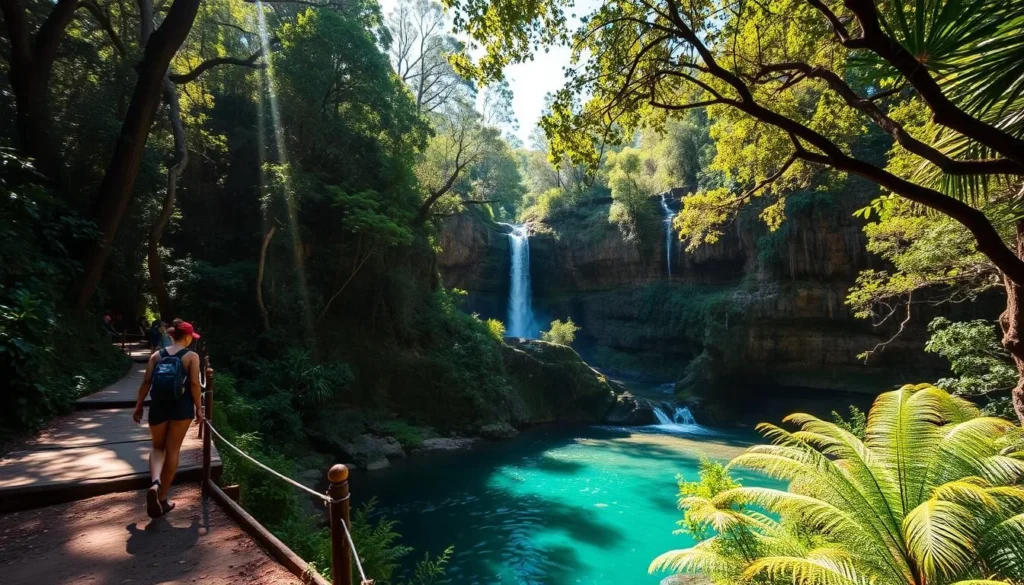
Crocodile Safety in Litchfield National Park
As you explore the wonders of Litchfield National Park, understanding the risks associated with crocodiles is vital for a safe visit. The park’s beautiful waterfalls and swimming holes are a major attraction, but they also pose a significant threat due to the presence of crocodiles.
Understanding the Risks
The wet season brings a heightened risk of crocodile sightings in Litchfield National Park. High water levels can bring crocodiles from the surrounding rivers and ocean into the park’s watering holes, making them unsafe for swimming. It’s essential to be aware of this risk, especially during and after the wet season.
Swimming Safely in the Park
To enjoy the park’s swimming pools safely, follow these guidelines:
- Always obey safety signs and closure notices. If a swimming hole is closed due to crocodile risk, do not enter the water.
- Stick to designated swimming areas that are regularly monitored by park rangers.
- Avoid swimming in unpatrolled waters, especially those connected to larger river systems.
| Safety Tips | Description |
|---|---|
| Swim in Designated Areas | Regularly monitored by park rangers |
| Avoid Dawn, Dusk, and Night Swimming | Crocodiles are most active during these times |
| Check with Park Rangers | For the latest information on crocodile sightings and water safety |
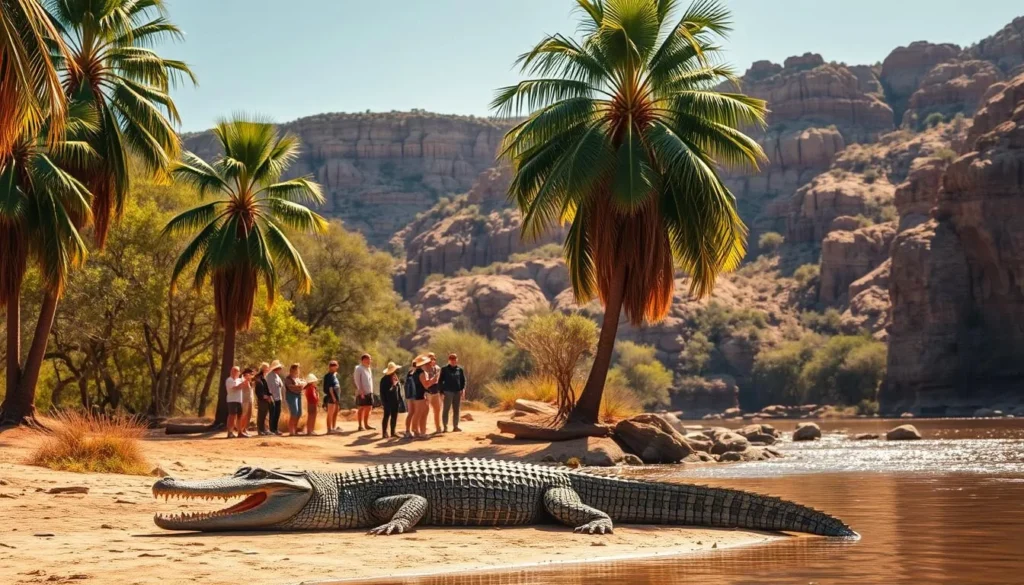
By being informed and cautious, you can enjoy the beautiful swimming holes and waterfalls of Litchfield National Park while minimizing your risk of encountering crocodiles.
Where to Stay in Litchfield National Park
Whether you’re looking to camp under the stars or enjoy the comforts of a luxury lodge, Litchfield National Park has something for everyone. Your accommodation choice can significantly enhance your experience, offering convenience, comfort, and a deeper connection with nature.
Camping Inside the Park
Camping is a popular way to experience Litchfield National Park. The park offers several camping sites that allow you to immerse yourself in the natural beauty of the area. Litchfield Tourist Park is a great option, offering powered caravan sites, air-conditioned cabins, and even a three-bedroom homestead for larger groups. Amenities include a swimming pool and café on site.
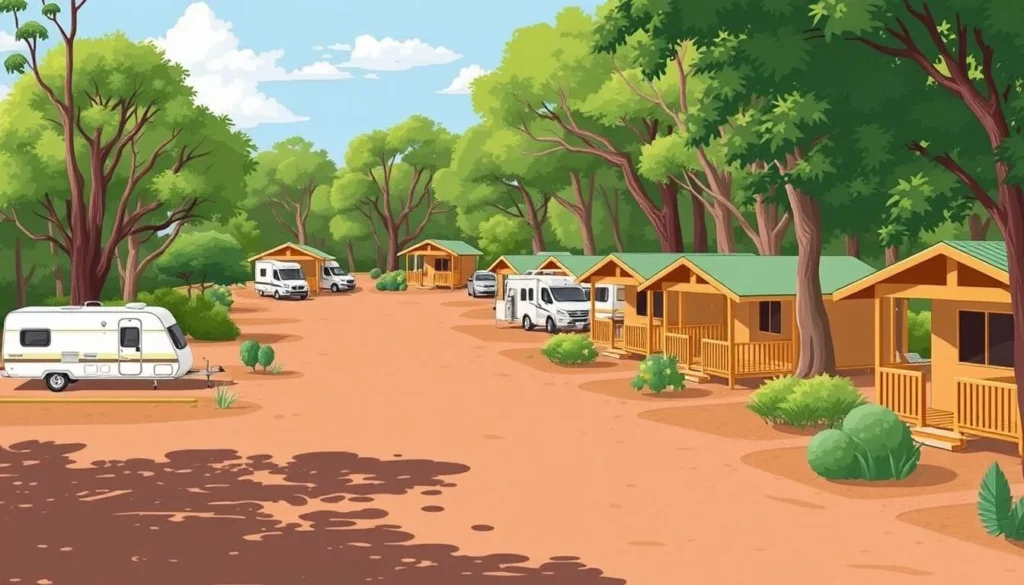
Accommodation Near Litchfield
If camping isn’t your style, you’ll find several accommodation options just outside Litchfield National Park in the nearby township of Batchelor. Hideaway Litchfield offers a unique experience with luxury safari tents and shipping container cabins, providing comfort with a touch of wilderness. Alternatively, The Banyan Tree Caravan and Tourist Park provides budget-friendly options, including motel-style rooms and cabins, with the charm of a bar under an illuminated banyan tree.
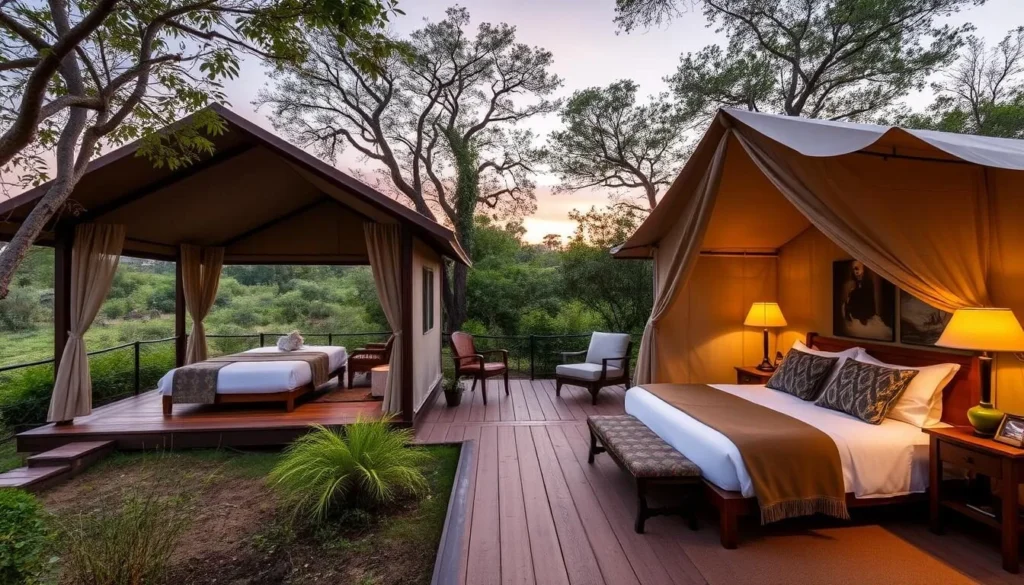
While staying outside the park means a slightly longer drive to attractions, it offers the advantages of reliable cell service, access to stores and restaurants, and typically more comfortable accommodations.
Guided Tours of Litchfield National Park
Guided tours offer a unique way to discover the wonders of Litchfield National Park. With expert guides, you can gain a deeper understanding of the park’s natural and cultural significance.
Day Tours from Darwin
A day tour from Darwin is an excellent way to experience Litchfield National Park’s highlights. For instance, Offroad Dreaming’s full-day adventure includes visits to Florence and Wangi Falls, a refreshing swim in the Buley Rockhole, and a stop at the Magnetic Termite Mounds. The tour concludes with a crocodile-spotting cruise on the Adelaide River.
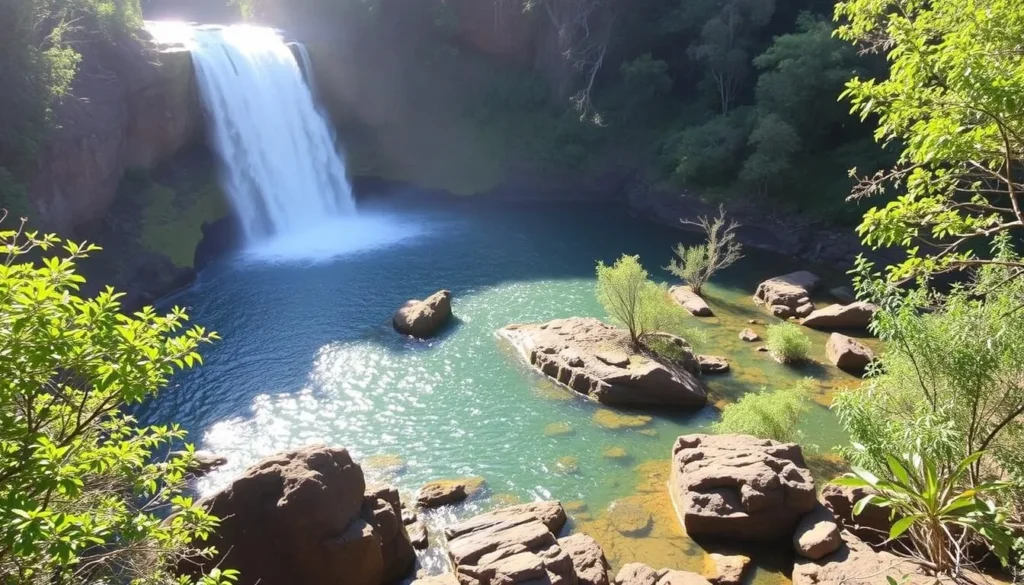
Specialized Tours and Experiences
Beyond standard day tours, specialized experiences offer deeper immersion into Litchfield National Park’s natural and cultural wonders. You can opt for Aboriginal cultural tours, photography tours, small-group 4WD tours, or multi-day camping tours.
- Aboriginal cultural tours provide insight into the traditional ownership and significance of the land.
- Photography tours time visits to coincide with optimal lighting conditions.
- Small-group 4WD tours venture to remote areas like The Lost City and Tjaynera Falls.
- Multi-day camping tours allow you to experience the park at different times of day.
These tours offer a more exclusive experience, allowing you to fully engage with the park’s natural beauty and cultural heritage.
Essential Tips for Visiting Litchfield National Park
To make the most of your visit to Litchfield National Park, it’s essential to be prepared. With limited facilities within the park, you’ll need to plan ahead to ensure a smooth and enjoyable experience.
What to Pack for Your Visit
When visiting Litchfield National Park, it’s crucial to pack wisely. Bring plenty of food, snacks, and water, as well as a picnic to enjoy at one of the many scenic spots. Don’t forget to download offline maps before your visit, as cell phone coverage is virtually non-existent throughout the park area.
Facilities and Amenities in the Park
The facilities within Litchfield National Park are basic but well-maintained. You’ll find clean toilets at all major attractions, including Wangi Falls, and hot showers are available at the main campgrounds. The small café at Wangi Falls offers basic meals and snacks during the dry season, but be sure to check the opening hours as they can be inconsistent. Picnic facilities, including tables, BBQs, and shaded areas, are available at most major attractions, making it easy to enjoy meals between swimming and exploring. Plan your visit according to the time of year and be prepared for the adventure ahead.
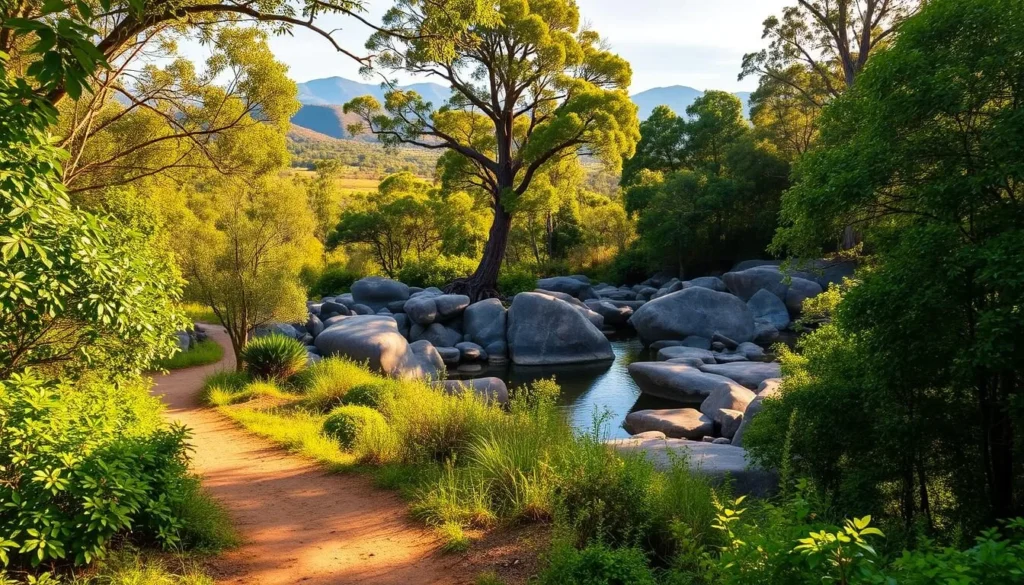
Seasonal Considerations: Wet vs. Dry Season
Your Litchfield National Park adventure can be greatly enhanced by choosing the right season to visit. The park’s beauty transforms dramatically with the seasons, offering unique experiences during the wet and dry periods.
Visiting During the Dry Season (May-September)
The dry season is ideal for exploring Litchfield National Park. With comfortable temperatures and minimal rainfall, it’s the perfect time for hiking and swimming in the park’s renowned waterfalls. You can fully enjoy the park’s facilities and attractions without the challenges posed by wet weather.
Experiencing the Wet Season (October-April)
Visiting during the wet season can be rewarding, as the waterfalls are at their most spectacular. However, be prepared for road closures and potential safety risks, such as saltwater crocodiles. The wet season brings dramatic landscapes and lush vegetation, making it a great time for photography. You should remain flexible with your plans and check park alerts before heading out.
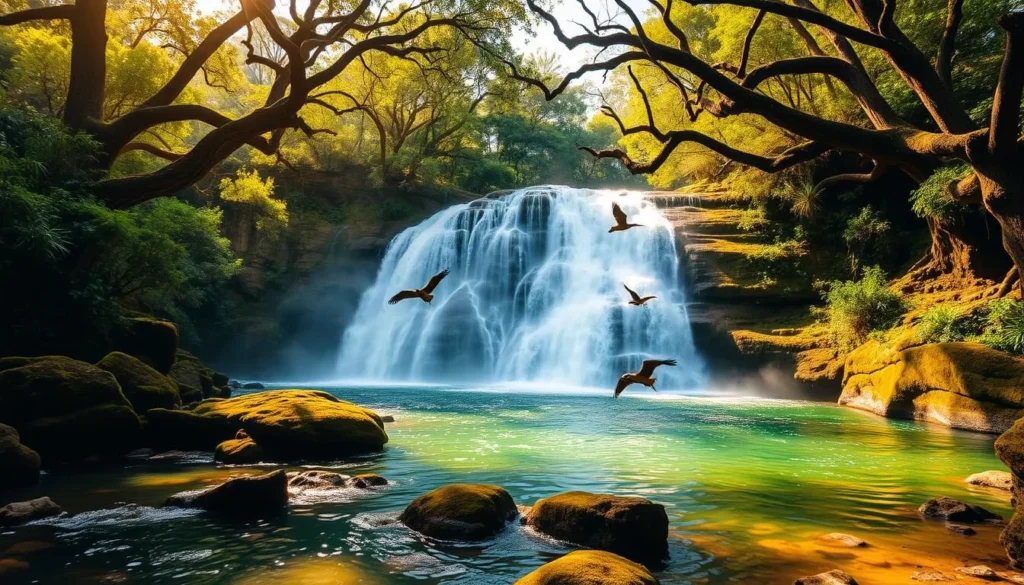
Conclusion: Making the Most of Your Litchfield Adventure
Litchfield National Park offers an unforgettable adventure, combining natural beauty with accessible amenities. As you visit Litchfield, you’ll discover a national park that caters to all experience levels. To make the most of your time, consider spending at least two full days exploring the park’s highlights and hidden gems. With a 4WD vehicle, you’ll unlock more secluded spots, while early mornings and late afternoons provide ideal conditions for visiting popular swimming holes. Whether you seek adventure or relaxation, Litchfield National Park promises an experience that will be a highlight of your Northern Territory journey.
The above is subject to change.
Check back often to TRAVEL.COM for the latest travel tips and deals.
